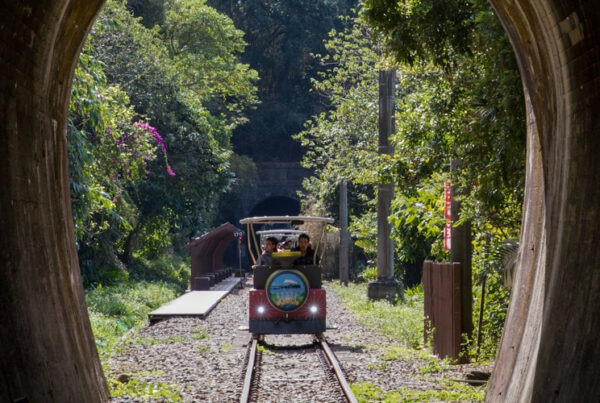Dongyuan in Pingtung County is like a “botanical garden,” a hidden-away mountain gem bursting with color where nature is allowed to be herself by her Paiwan Tribe custodians.
Text: Rick Charette; Photos: Chen Cheng-kuo
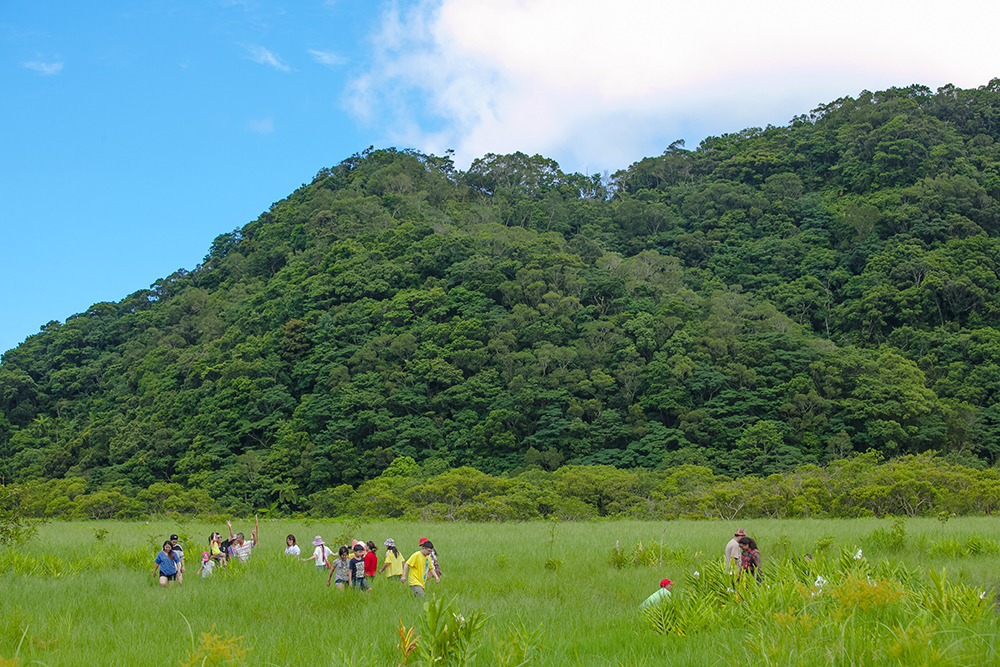
Dongyuan Wet Grassland
As we turned off Pingtung County’s east-west Provincial Highway 9 and headed south along the narrow and twisting, yet well-paved and -maintained County Highway 199, which meanders its way toward the very popular tropical Kenting National Park on Taiwan’s far-south tip, the impression quickly built that this was one of the prettier roads I’d been on in Taiwan.
We were in the deep-south section of Taiwan’s long, thick central-mountain spine. There was thick foliage on both sides; trees leaned over the road as if in welcome, presenting the gift of dappled shade on this bright, hot day. There was a strong scent of blooming flowers and busy butterflies and birds flitted about. Ever so often we’d catch a glimpse of the Pacific to the east, far below and beyond.
We had entered Biya’s world. Mudan Township is Paiwan Tribe country. Our destination was Dongyuan, one member of Taiwan’s southernmost cluster of indigenous settlements. It was early July, this was the first weekend of Dongyuan’s annual Ginger Lily Festival, and Biya (whose Chinese name is Sun Ming-heng) was to be our guide.
Adding to the color of our approach on Highway 199 was a steady stream of huffing, puffing, bright-garbed cyclists headed uphill the other way. Biking has exploded in Taiwan, and the 199 is part of a popular round-island cycle route. Here, on the Hengchun Peninsula’s east side, the coastal highway is interrupted, so riders, literally and figuratively, face an uphill battle when heading north from Kenting National Park.
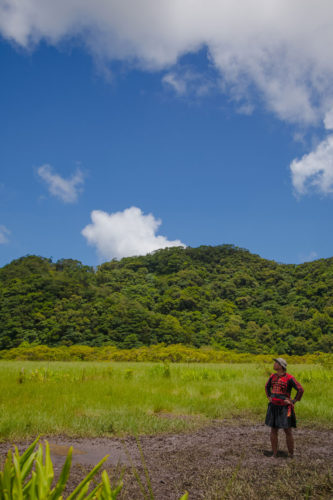
Dongyuan Wet Grassland
Biya, decked out in traditional warrior ceremonial garb, met us at the wood-theme entrance to the community’s pride and joy, the Dongyuan Forest Recreation Area (NT$100 entry fee). Before us was a lovely small lake, thick with lily pads and reeds along its sides, bursting with the year’s wild white ginger lily bloom. On the far side was a large grove of tall trees shading a park-like area busy with people.
“Dongyuan is in a mountain depression,” Biya began his introduction. “It is oblong-shaped; the northeast end, where we are, is higher than the southwest end. Roughly speaking, the shape is like a tongue, and in fact when the Japanese controlled Taiwan (1895-1945) they simply named the place ‘mouth,’ which we pronounced ‘Jiaguji.’ Again, roughly speaking, our village runs along the middle of the tongue’s north side, along the main road. We use this lake and mahogany-grove area as the tourist entrance to the forest recreation area, which runs higher up along the edge of the tongue behind and down beyond the village. At the tongue’s bottom is a huge bog, the Dongyuan Wet Grassland, which is a protected area.”
The community offers eco/culture tours to visitors (about 2 hours), which take in the lake-perimeter trail, forest grove, village spots, and bog. Biya first took us around the trail, which also goes through the grove, called the Aroma Forest.
“The Dongyuan community is a sub-tribe of the Paiwan Tribe, Taiwan’s second-largest indigenous group. Today we number about 500. The Paiwan have long lived in the hills and mountains of the far south, away from the coasts, for safety. In the past, this depression was empty, and this lake area was marsh. The Japanese used the marsh and bog for military training for troops destined for similar conditions in Southeast Asia. After they showed this place to some tribe members, our community moved here from the upper Fangshan River (north of Highway 9), attracted to the pristine, abundant water resources. The marsh was dammed and used for fish farming, and the water used for rice-paddy irrigation.
“The name ‘Dongyuan’ was chosen because we are east of Mudan, the largest area village, and in a headwater catchment depression; so ‘Dongyuan,’ meaning ‘eastern source or fountain. The lake is formally called Dongyuan Lake, but is also called Crying Lake. People believe some sad or mysterious Paiwan tale must be the source, but in fact the reason for the name is that the Chinese for “crying,” kuqi, sounds like the original name ‘Jiaguji.’

Crying Lake
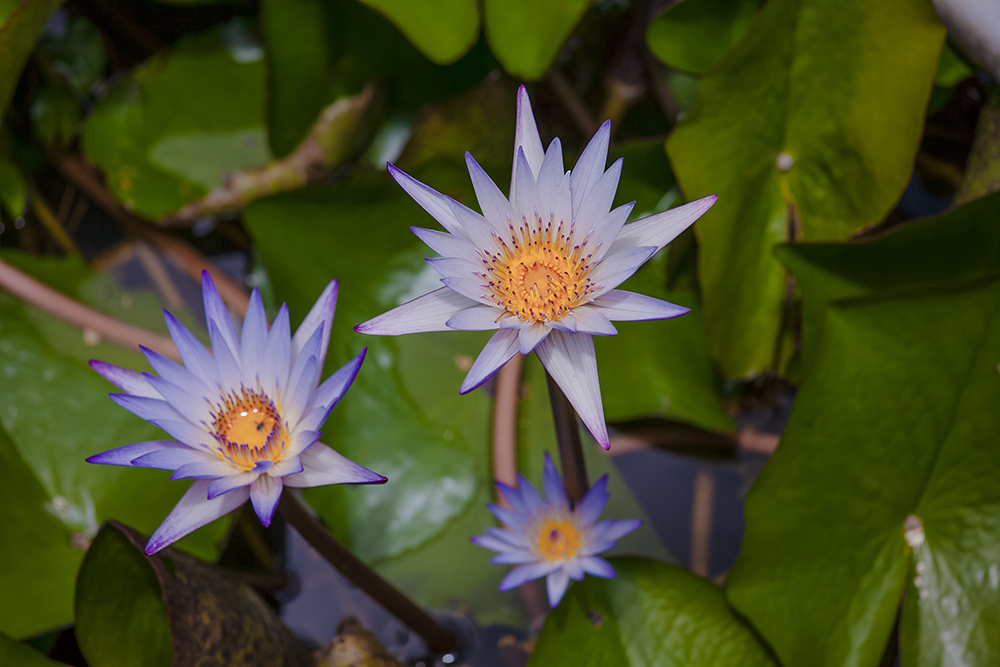
Lotus flowers
“The lake has now been allowed to return to its natural state, and we’ve introduced wild ginger lilies, not here before, for tourism purposes. They’ve long been important in Paiwan culture, used to strengthen stream and pond banks, in herbal medicines, and in our foods. In fact, during the Japanese era, the Mudan area was called Taiwan’s ‘botanical garden’ – wild peonies, wild ginger lilies, and other wildflowers grew in abundance, decorating the landscape.”
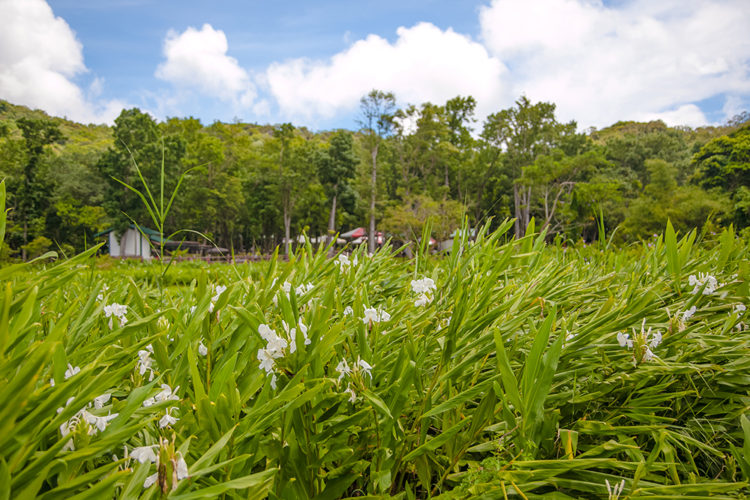
Ginger lily plants
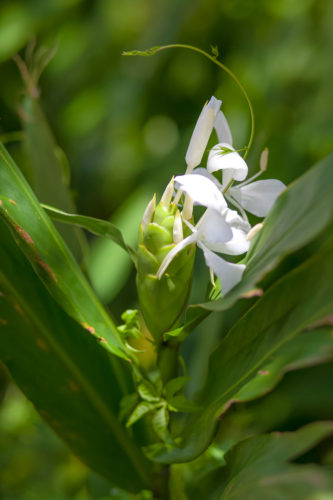
Ginger lily
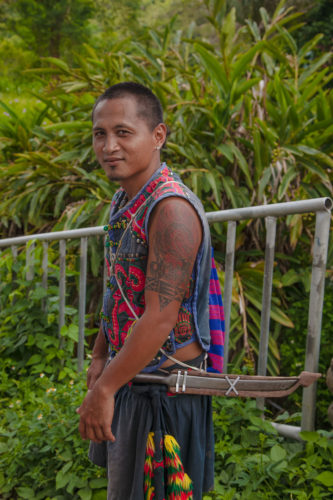
Young member of the Paiwan tribe
Under normal circumstances our tour would have continued at this point through forest grove, village, and bog, but Biya said he had a surprise in store for us. The day’s first song-and-dance show was about to begin on the Aroma Forest’s timber-frame stage. The Paiwan, though best known for their arts-and-crafts talent – notably woodcarving and bead-work jewelry – also have a rich musical heritage.
“Our traditional music is harmonic, sung in groups rather than solo,” Biya explained. “Songs usually tell a story, and are sung in unison, in two-part polyphony, which includes an upper melodic voice and drone (i.e., an ostinato). You also see this style in one of the special traditional instruments we play, the nose flute. With our double-cylinder nose flute, one (cylinder) has holes and the other does not; the second creates the drone/ostinato sound that accompanies the music.”
And then, to our surprise, he showed us just how, for it turned out Biya was a scheduled performer and his group was just taking the stage. After their performance he explained that, traditionally, young men would play nose-flute music when romancing young women.
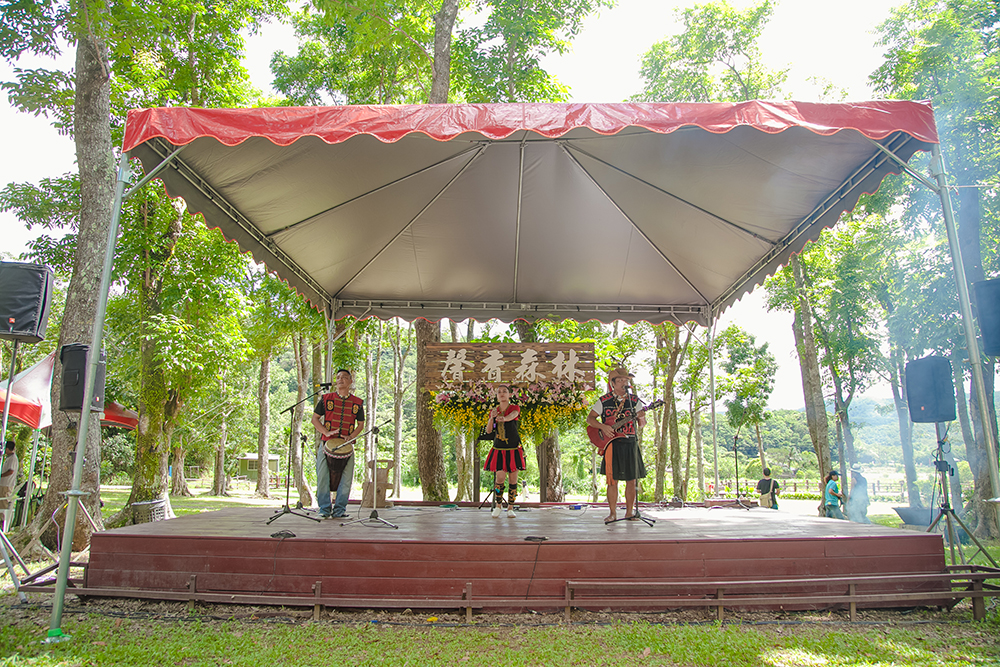
Music performance at the Ginger Lily Festival
This was the first day of the annual Ginger Lily Festival, and Biya provided us with a bit more background. “The lily bloom is June~November, and we stage the festival early July through late September. Each day we have a rich full-day schedule of Paiwan-culture music and dance shows, our Aroma Forest market, traditional-style feasts, guided eco/culture tours, and many different DIY experiences. All of these are also available outside the festival, but on weekends only, and on a reduced level.”

Traditional ritual of the Paiwan tribe
After this our walking tour continued, Biya leading us through the village to the Dongyuan Wet Grassland. Our barefoot exploration was a great lark. Beyond the enlightening eco-background provided, it was a gas romping around the squishy, spongy peat-bog surface – my first-ever such experience – almost as excitedly tickled as the kids from other groups all around.
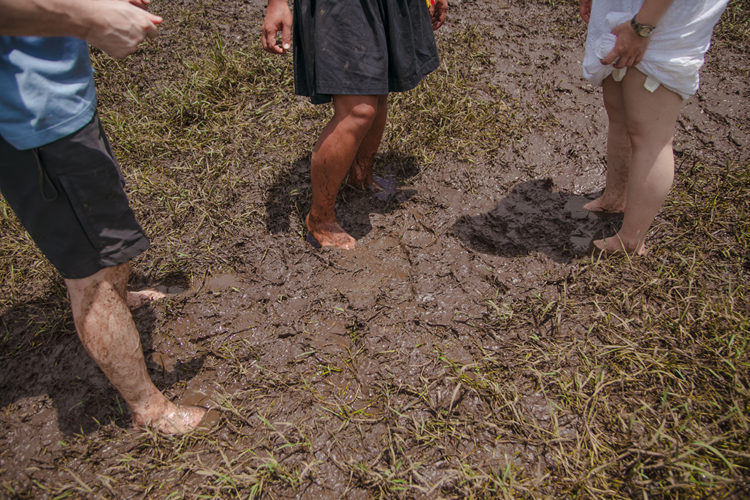
Exploring the muddy Dongyuan Wet Grassland
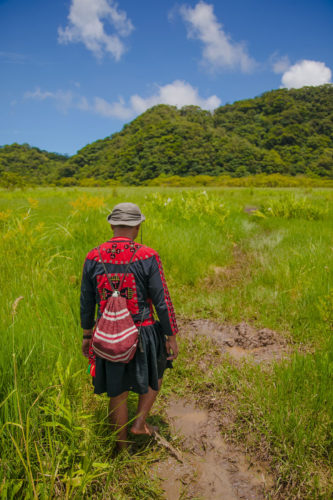
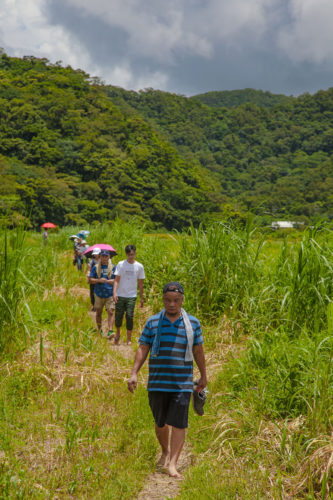
“In the old days this was a mysterious, frightening no-go place,” Biya informed us, “because back then healers would ritually drive the evil spirits that made villagers sick into the ‘inescapable’ bog. Today some elders remain wary, but the wet grassland is now an irresistible tourist draw, and we even stage bouncing song-and-dance performances here. It remains sacred, however, and access is allowed only with Paiwan escort.”
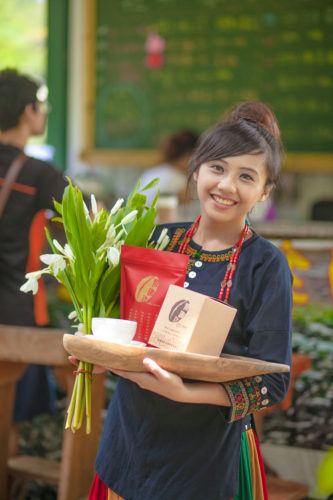
Young member of the Paiwan tribe
We finished our Dongyuan visit with a tour of the Aroma Forest’s wood-theme retail and food-and-beverage stands, then sat down to a hearty indigenous-theme meal in the covered picnic-table eating area, which gives you an unobstructed view of the stage performances going on. Naturally, unique local products are emphasized.
At the beverage stand, which we made our way to a number of times on this blazing-hot day, especially enjoyable was the lemon juice made with cane sugar and ginger-lily flavoring, the wild ginger-lily extract – which is drunk cold on its own or added to teas and other drinks – and the coffee made with village-grown Arabica beans, just a bit deeper and more bitter than standard Arabica-bean brews.
The extract and beans are both packaged for take-home sale; packages of both have been greeting me in my kitchen each morning since my return home. Also stimulating pleasant memories is a range of ginger-lily products that graces my bathroom and my wife’s dressing room: ginger-lily perfume, presented in a scented wooden box, ginger-lily shampoo, body wash, and body lotion in both bottle and vial sets, and even anti-aging/hot-spring soak masks.
Best of the flavorful best of the wide-ranging native-theme repast (the set meals run from NT$150 to $350) was the classic stone-grilled roast boar, range chicken with basil, bamboo-tube rice, and jinafu, a delicious tamale-like treat made with ground millet, glutinous rice, minced pork, etc., wrapped in mildly bitter edible leaves. A Dongyuan twist on aiyu jelly, a popular Taiwan summertime cooling treat, is the wild ginger-rice jelly.
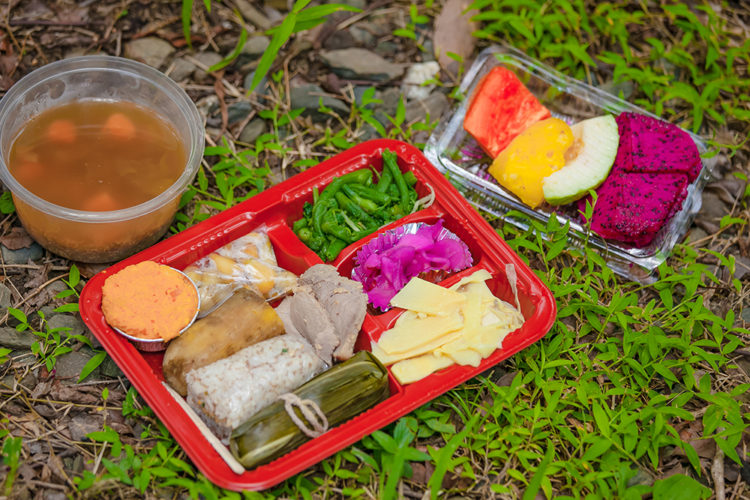
Paiwan lunch box
For more information on Dongyuan events and to book a guided tour, call the Mudan Township Dongyuan Community Development Association (0905-232-199). The fee is NT$2,000 for groups of 20 or more; smaller groups/individuals are pooled, each person paying NT$100. There are also a number of other area tourist draws well worth your time, notably the Mudan Reservoir and Shimen Ancient Battlefield; for more information, visit the “i Love Pingtung” website (i-pingtung.com).
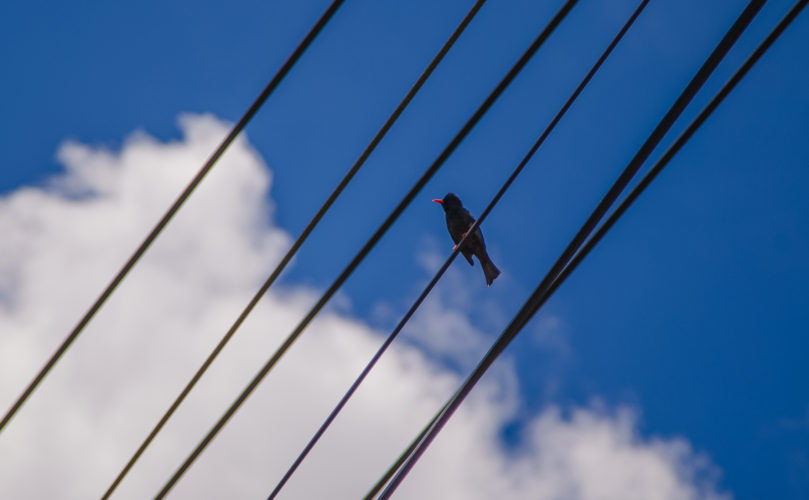
Black bulbul
About the author

Rick Charette
A Canadian, Rick has been resident in Taiwan almost continually since 1988. His book, article, and other writings, on Asian and North American destinations and subjects—encompassing travel, culture, history, business/economics—have been published widely overseas and in Taiwan. He has worked with National Geographic, Michelin, APA Insight Guides, and other Western groups internationally, and with many local publishers and central/city/county government bodies in Taiwan. Rick also handles a wide range of editorial and translation (from Mandarin Chinese) projects.









